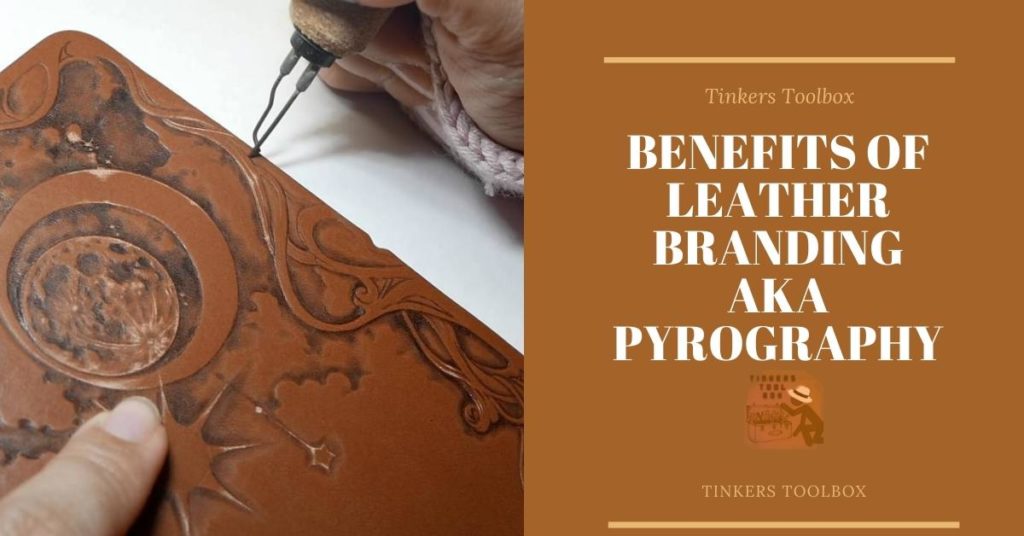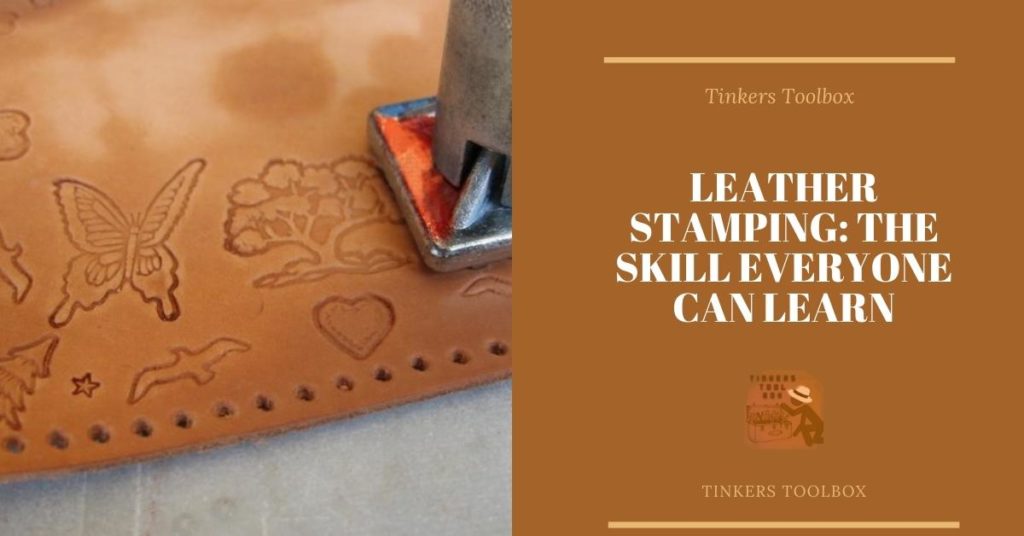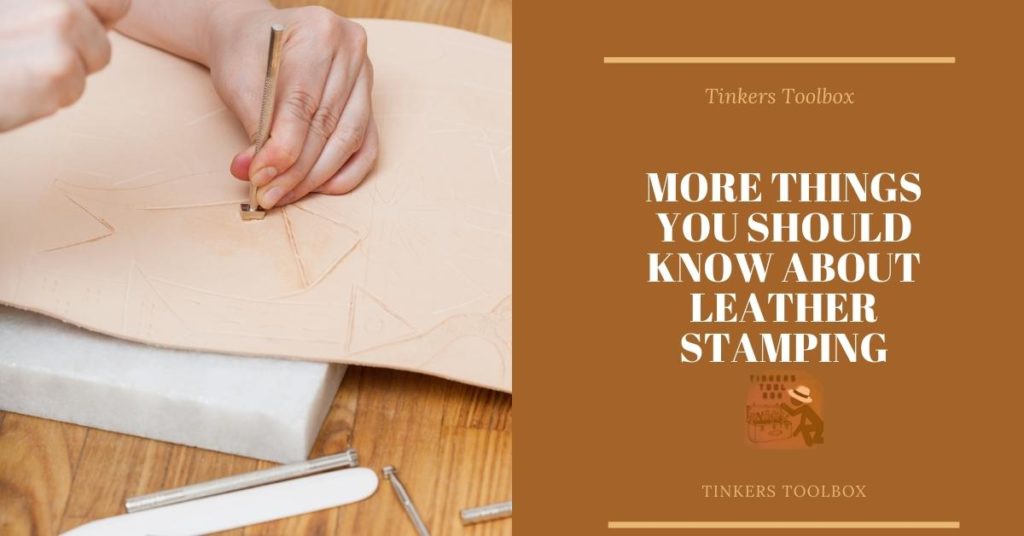One of the things people often do to make their leather projects look more personalized and customized is stamp designs, letters, signs, or any trademarks to sell them to other people. Others burn images on the leather surface through branding. However, not many people understand how they are different since they both do the same purpose — imprint designs on the leather surface. This article talks about these two different methods and their similarities and differences for further understanding.
Leather branding means burning a design on the surface of the leather using either a pyrography pen, an electric leather burner, a wood leather burner, or a standard leather burning kit. Leather stamping is the process of stamping designs on the surface of the leather using pressure.
This article will discuss everything you should know about leather branding and stamping, each with separate sections. You will also learn the differences and similarities between these two leatherworking methods and how to use branding and stamping in your leather projects.
Leather Branding: Imprinting Designs With Heat

Leather branding refers to burning the surface of the leather with designs to decorate the surface. Leather branding is also known as pyrography. Leather pyrography is an ornamental leather method that involves burning designs on the grain surface of the leather with a scorching leather instrument. Vegetable-tanned leather is ideal for leather pyrography since it is not chemically tanned and burns nicely.
Pyrography is derived from two Greek words: “pur,” which means “fire,” and “graphos,” which means “to write.” As a result, it literally signifies “writing with fire” when placed together. While pyrography is still used for writing, it is now more commonly used for drawing, branding leather goods, and design, among other things.
Pyrography is the process of etching drawings, words, or designs on the surface of materials such as wood, leather, gourds, paper, or any other material that won’t be destroyed by the burning tool’s dry heat. We learned how prehistoric man, commonly known as cavemen, utilized charred sticks to mark and burn wood from history.
As a result, it’s easy to see how wood has been the natural medium of choice for pyrography from ancient times. However, because wood is an organic substance that deteriorates with time, most of the early pyrography work has been lost because wood could not endure thousands of years.
However, some research suggested that pyrography dates back to the Han Dynasty (206 BC – 220AD) used as fire needle embroidery in ancient China.
Benefits of Leather Branding aka Pyrography

It is a lot easier to imagine what these two names signify when they are married together if you have a good understanding of what leather and pyrography are. Leather pyrography is the process of using a burning tool to create designs or writings on leather, as I have mentioned earlier.
Burning on leather is a lot of fun, and pyrography on leather is a lot of fun. Unlike wood, leather does not have any grains to contend with. The heated burning tool’s points or nibs will sink into the grain side of the leather, allowing you to burn your impressions neatly.
Pyrography on leather is extremely smooth and quick; however, due to the grain structure of wood, this level of smoothness will be difficult to attain. Another amazing feature of leather pyrography is the ability to create a wide range of tones, hues, and highlights in a dramatic manner. The rustic sepia aspect of leather pyrography is its true artistic charm.
Different Tools Used in Leather Branding or Pyrography

Fortunately, leather pyrography does not necessitate a large number of tools to get started. While just a few tools are required to get started, it is critical to equip oneself with the appropriate equipment.
Getting a pyrography kit is a good place to start if you’re new to leather pyrography. A pyrography kit is inexpensive and comes with various pens, tips, and other auxiliary items to get you started. You can eventually purchase high-end alternatives if you decide to take leather pyrography more seriously.
Some of the tools you will need in learning about leather branding include the following:
- Leather, of course
- Leather burning tool
- Stencils for tracing
- Tracing or carbon paper
- Stylus or pencil, whichever is applicable
- A smooth surface to do leather brandings, such as a marble or a granite top
More Things to Know About the Leather Burning Tool

Obviously, the most crucial instrument for leather pyrography is the leather burning tool. In simple terms, a leather burning tool is a handheld tool with a handle that resembles a pen and a burning point.
The most crucial things to keep in mind while using your burning tools are that the handle is constructed of heat-resistant materials and that the tip is adequate for the type of burn you’re rendering. You can always begin with the most basic pyrography techniques!
There are many burning nibs to choose from; what matters is that you get used to and comfortable working with them. Frankly, I believe that having a controllable leather burning instrument is preferable.
The Pyrography Pen: Another Viable Option

One of the most popular tools in leather branding is the pyrography pen. Originally used in woodworking, some leather craftsmen have found a way to use the pyrography pen in leather branding. However, it requires a lot of skill and experience using the pyrography pen to produce better designs in leather branding than a leather-burning tool.
Hence, this is only recommended if you are skilled in using the pyrography pen as a woodworker and a leather craftsman. There are instances that the leather can be scorched and burned because the leather craftsman has failed to control the pyrography pen to create their desired looks.
Leather Stamping: The Skill Everyone Can Learn

On the other hand, leather stamping is very popular among leather craftsmen of varying degrees of expertise because it is much easier to learn than leather branding. It does not require any complicated skills or expensive tools to acquire before learning the skill. It is also very useful, both in personal and business projects, and many people love it.
Stamping is simply the process of leaving a 3-D impression on your leather with a stamp, which is usually made of metal. Letters, numbers, forms, and artwork can all be used in this way. These instruments come in a variety of sizes and styles.
More Things You Should Know About Leather Stamping

I will tell you more things you should know about leather stamping, which includes some tips and tricks that you can use or things you should remember before doing it.
Stamping leather is a fascinating way to build something unique out of the material. Diary covers, name tags, luggage tags, and other items can all be customized. Leather stamping is not difficult to learn, and you will be able to do it in no time.
There are many ways to stamp on leather: using pressure stamps, ink stamps, or leather embossing stamps. Others are also using 3D leather stamps, which is perfect if you want to capture all the details of an intricate design and transfer it to the leather surface. Whatever result you want, always remember that leather stamping is easy to learn, so you should spend more time perfecting your craft.
You must remember to do stamping on a flat surface, preferably the marble or granite slab you have used in your other leatherworking projects. Suppose you stamp your leather on an uneven surface. In that case, the uneven surface will also leave an indent on the leather surface.
It will make your leather look uglier because of the uneven bumps and cuts. Stamps on the leather show up much better if you do it on a flat and clean surface, which will add a level of sophistication to the finished product.
How is Leather Stamping Compared with Tooling?

Leather stamping and leather tooling are basically the same processes, with tooling being the more technical term for the process. Leather stamping is also known as tooling, which is the process of embellishing and embossing designs on the surface of the leather through pressure stamps, or the stamps that you strike with a mallet to leave an imprint on the surface.
Different Leather Stamping Tools: A Refresher

Again, I have written a more in-depth article about leather stamping tools. Still, I will be giving you a refresher for those who do not have the time to click my other article (but please do, because it will teach you many things you should know about leather stamping, especially if you are a beginner).
Different tools are dedicated to leather stamping. Some of those tools include the stamping kit and the mallet, which can be the one you have been using in your other leatherworking projects.
A stamping kit can be composed of symbols, letters, numbers, signs, and designs that you can use to stamp on the surface of the leather. Using a mallet, you can strike the top of the stamp, and the force will cause the embossed tip to push itself on the surface of the leather. The design will be left on the surface. You can do it repeatedly using different designs to achieve your desired results.
Leather Branding vs. Leather Stamping: The Real Deal

Now that you know the various tools, methods, and processes involved in leather branding and leather stamping, now is the time to see which one is much better in terms of your leatherworking projects.
To be completely honest, it actually depends on where you want to use it. If you want to use it on your personal or small gifts to friends and family, you want to sell these leather projects you have been working on to other people.
Objects that are leather stamped often exude a more rustic aura and a more handcrafted feel, which heightens the uniqueness in the object. Suppose you want your leather projects to have a more personal feel without feeling manufactured or too perfect. In that case, leather stamping is the way to go. Having imperfect stamping instances on the leather surface can add more to the charm of the leather projects.
On the other hand, if you want your designs to be more perfect and polished and sell them to other people, you might want to consider leather branding. Leather branding adds more feel to the leather because of the burnt qualities, which can charm other people outside your zone. Products made intending to sell should be made as perfect as possible, and this one can seal the deal for you.
Even though imperfections are cute and adorable in some instances, you have never seen a high-quality bag from Prada or Dior that was stamped awkwardly or imperfectly. Products should be made impeccably, without any faults or flaws, and leather branding can give you that security level in keeping the designs accurate.
One thing you should also consider is your level of expertise. Leather branding requires skillful use of the pyrography pen or any branding tool that you will use, so if you are a complete newbie in the leather branding game, you should opt out of this and practice more. You might also injure the leather surface and yourself if you do not know how to control the leather branding tool properly.
Conversely, leather stamping is for everyone, and even beginners can do that. There is also no need to learn any special skill, unlike leather branding. As long as you are confident with your strikes, you are already set to succeed with your stamping kit for your leatherworking projects.
Give Your Leather Projects an Added Oomph
Whether you choose leather stamping or leather branding, these two skills will surely ramp up your leatherworking game because you can use any of the two skills to ensure that your leather projects would have that added oomph factor that sets them apart from others. Personally, I am comfortable with both methods, and I am fine using either of them. I am sure that you will find which one you find much easier to use the more you learn about leatherworking. I do hope that I was able to help you choose which one suits your preferences.















